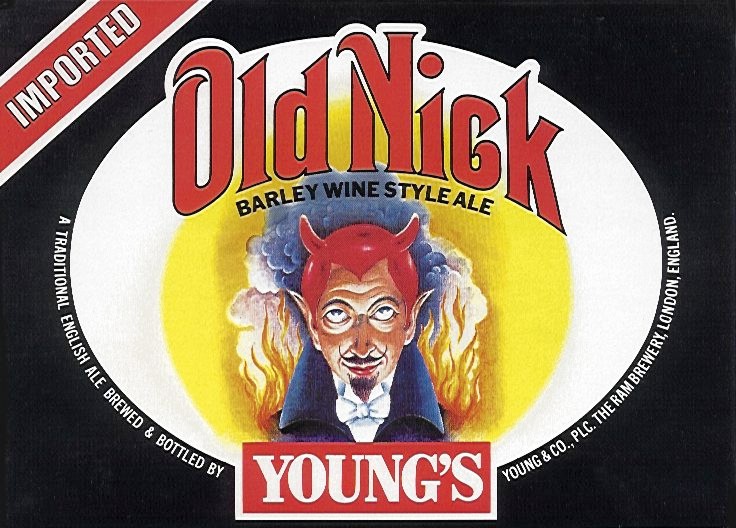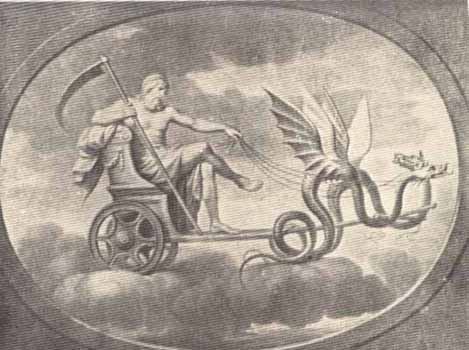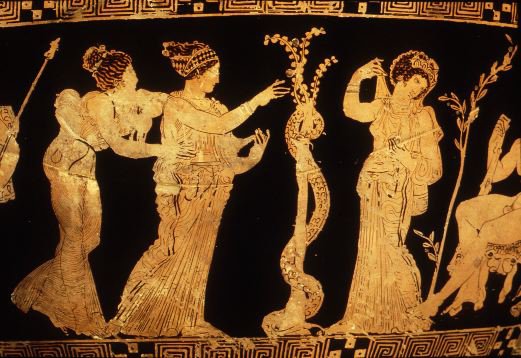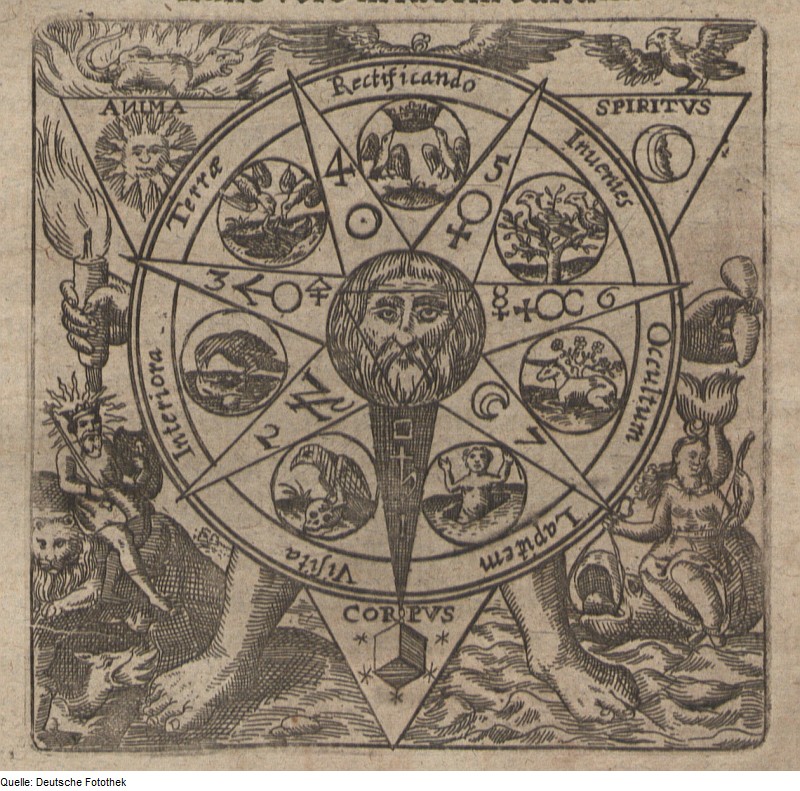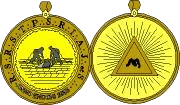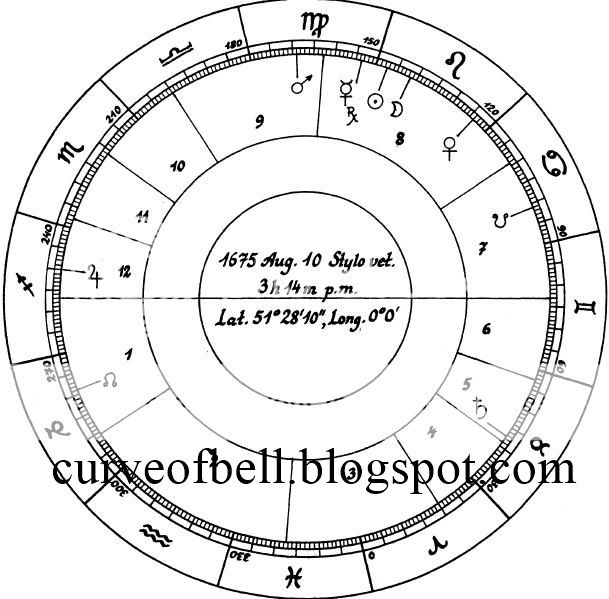As daylight dwindles and even the chill of autumn begins to seem to us a warm memory, we are beset from all sides by bad news. From relentless Centers for Disease Control flu alarmism to the repeated warnings of the imminent threat of economic catastrophe – on this, the 100th “birthday” year of the Federal Reserve – we are, it seems, infected with the dreaded “seasonal affective disorder.” To put it less clinically, our spirits flag and winter’s icy fingers extend from their polar stronghold to tighten their grip on our collective neck. Oh, “…[r]espite! Respite and nepenthe…”.[1] Exasperation drives the question: “Lord, to whom shall we go?”[2]
When, “what to our wondering eyes should appear” but that endangered species of architectural burlesque, the contemporary Cathedral of consumerism that is a shopping mall.
Hundreds of poor wretches scramble inside. On each heart is the hope of exchanging a wad of rapidly devaluing cash for just a little taste of Christmas cheer.
But, Lo! Who is this in the midst of this hustle-bustle, serenely enthroned, on a garish chair, in an ostentatious bright ruby-red getup?
In “normal” circumstances, such an apparently dreadful fashion sensibility would alert the style-conscious mavens of 21st-century America to the presence of mental disorder. Forthwith would commence a predictable process of social ostracization – punctuated, perhaps, with 50,000 volts bursting forth from the taser of some excitable police rookie or rent-a-cop charging forward toward the red menace like an enraged bull after a muleta.
Here however, amongst the surrounds of this luxuriantly festooned galleria, the figure decked out in a brilliant scarlet and snow-white outfit has all the animal charm of a living lodestone. The crowd is scattered about him, transfixed – like bits of iron frozen under the invisible influence of a tremendous red magnet.
And the children – how they throng the open space! Each tiny form draws slowly and inexorably in towards the jolly fat man, like a doomed little planet caught in the gravitational field of a red giant star. Most remarkably, on impact, they spill their little guts, some sobbing wildly, while others whisper secret desires into this stranger’s ear!
Is this the latest in the Nefarious Surveillance Agency’s bid to keep tabs on Americans? Is this some secret agent masquerading about, donning this absurd disguise and proffering an assumed name? Is it a modern retelling of the age-old tale of a wolf going hunting in sheep’s clothing?
No! It’s Santa Claus, of course. Alias Kris Kringle.[3] Alias Father Christmas.[4] Alias…Saint Nick! So check this out as “the jolly old elf” is cartoonized into a predatory cat licking his chops over delectable mice – or kiddies? – from Santa skeptics at MGM as early as 1935. (You may need to turn up the volume a bit on this one. Also, be sure to check the endnote to see what those movie folks were doing at their own studio Christmas parties. Adults only, please!)[5]
Who is Santa Claus, really?
Consulting the popular source Wikipedia, one learns about Santa’s proximate origins in a Dutch figure labeled Sinter Klaas. Supposedly a bastardization of Sint Nikolass (“Saint Nicholas”), Sinter Klaas is alleged to be a reference to a 3rd-4th century Lycian bishop named Nicholas of Myra.[6]
The well-known 19th-century short story writer, Washington Irving, included a surrealistic vignette in his A History of New York (1812 ed.), a fanciful pseudo-history of the Dutch settlers of New York first published on St. Nicholas Day in 1809, that depicted St. Nicholas taking flight.[7]
According to this version, our beloved Santa Claus is thus said to be a sixteen-hundred year throwback to a real-life Christian holy man with a penchant for outrageous magnanimity – a prominent example of which involved, as the story goes, sacks of gold making their merry ways down a chimney[9] (on which more below), traditionally the “devil’s corner” in European folklore, saving three penniless maidens from lives of humiliating whoredom.
It seems that enthroned in our malls is generosity personified: good ol’ Nick himself (or a reasonable facsimile thereof).
Or is it?
Some allege that there’s something sinister lurking under those classic Santa features.[10] You know the ones we mean. As envisioned by the theologian-cum-poet, Clement Clarke Moore (or could it have been Henry Livingston, Jr.?), and popularized, first by greeting card pioneer Louis Prang in fin de siècle America, and then by the Coca-Cola company in vast advertising campaigns during the 1930s, we’re referring to those twinkling eyes, rosy cheeks, cherry nose, droll mouth, snow-like beard, and plump belly.
Is this the face of evil?
Considered as an anagram, the letters of his name S – A – N – T – A, can be rearranged to generate the proper noun Satan.[12] This point was made especially memorably by the Saturday Night Live character, the Church Lady (Dana Carvey).
“Church Lady: Hello, I’m the Church Lady, and this is ‘Church Chat.’ Well, you know, the holiday season has arrived. And, with it, a little letter from Toledo, Ohio. Let’s read that, shall we?
“[ reading ] ‘Dear Church Lady: I am shocked at the number of people who bring their children to total strangers in Santa suits, and allow them to hold their young ones firmly on their pelvic regions, offer them candy and whisper, Don’t be afraid to tell me what you really want! What causes this mass hysteria?’ Signed, Elaine.
“Well, Elaine, let’s examine the word ‘Santa,’ shall we? [ holds up board with ‘SANTA’ spelled across it in removable letters ] Santa. Let’s see, what have we got here? We’ve got an S and an A, an N, a T, and another A. Hmm.. [ rearranges the letters ] Who could be causing all those laps to bounce up and down curiously? Who would help grown men peel the focus from the baby Jesus on his birthday? Who could it be, I just don't know. Could it be.. [ echo ] Satan?!?! [ the letters now spell ‘SATAN’ ]”[13]
There is much more. The “good ol’ Saint Nick” moniker is an echo of a popular sobriquet for the Devil himself: Old Nick. The Online Etymology Dictionary relates that this usage of “Nick” was in place “…by the 1640s” adding that “…the reason for it is obscure.”[14]
Terry Gilliam incorporates this designator into his odd 2009 flick, The Imaginarium of Dr. Parnassus. Otherwise known as the ill-fated “Joker”-actor Heath Ledger’s final film (he died midway through filming), Gilliam’s devil-character is called “Mr. Nick.”
This sinister current in the Santa tradition has some disturbing synchronicities. Consider, for instance, the infamous – and still unsolved – murder of the six-year-old girl, JonBenét Ramsey.
The basic contours of the incident are fairly widely reported as follows. On December 26, 1996, the lifeless body of the “beauty pageant princess” was discovered in the basement of her family’s house in Boulder, Colorado. Her date of death is now given as Christmas.
Besides the child’s parents, John and Patsy Ramsey, numerous suspects have been suggested. One such candidate was: “William 'Bill' McReynolds, a retired University of Colorado journalism professor who gained unwanted notoriety as the man who played St. Nick[15] for the family of JonBenet Ramsey…”.[16]
“McReynolds and his wife, Janet, both came under some scrutiny as potential suspects…, not only because he’d been in the house shortly before JonBenet’s slaying, but also because police discovered two eerie parallels between the McReynold’s lives and details from the Ramsey case.
“For one, it was discovered that a daughter of McReynolds, plus another young girl, had once been abducted in Longmont[, Colorado, northeast of Boulder] by an unknown assailment. The second girl was molested. The McReynolds girl, 9 at the time, was not. Both were released within hours. The date of the incident was Dec. 26, 1974 – 22 years[17] to the day before JonBenet’s murder was discovered.
“Additionally, police learned that Janet McReynolds had written a play in 1977, Hey Rube,[18] based on the 1965 torture-murder in Indiana or a teen-age girl who – like JonBenet – was found dead in a basement.”[19]
Regarding the real-life apparent abduction of her own daughter, Janet McReynolds reported that the captor “…had a change of heart. He wept and said, ‘The Devil made me do it.’ He drove the girls back to the edge of town and released them.”[20]
Although Sinter Klaas himself is usually cast as “…a protector of children”,[21] aggression against children is a component in the lore of Sinter Klaas’s “assistant.”[22] In this vein, we should examine the Dutch tradition, periodically denounced from predictable quarters as being “racist,” of depicting Sinter Klaas with a “dark helper.” Named Zwarte Piet, that is “Black Pete,” the curious figure, who now executes inoffensive tasks such as tossing sweets (snoepgoed) to the kiddies, once performed the more antagonistic rôle of punishing ne’er do wells.[23]
“‘Sinterklaas’ travels from Spain by boat, accompanied with his white horse and an agile Moorish slave called ‘Black Peter.’ …For the naughty, there’s nothing. And for the really bad, an awful fate awaits as Black Peter searches them out in the night, even if they try hiding under their beds. When he finds them, he stuffs them into a canvas sack and drags them back to Spain, where they are drowned in an inkwell or ground up into pepper.”[24]
According to some accounts, Black Pete owes his dark color to the fact that he, and not particularly Sinter Klaas, gains entrance to various houses by way of their soot-lined chimneys. There are chimney-connexions with Thor (see the above link[25]) and Harry Potter, both recently depicted in multiple blockbusters, as well as with the arch-Freemason, John Theophilus Desaguliers, who, besides being a grand master of the Grand Lodge of England and an early-day scientist, also busied himself with the study of chimneys.[26]
Perhaps, as Clayton L. Wright playfully imagined in his satirical “Masonic Christmas Card”:
“… ‘Why Santa!’ he shouted and lowered his blade, | ‘I see you’re a Mason!’ the Tyler relayed | …Adorned like the Master’s, complete with a sign | Of ‘Lodge Number One, the North Pole’ on one line! …”.[27]
“Soot,” in turn, is etymologically connected to the mythical Egyptian lord of chaos, Set. Even about Saint Nick himself, we read in the aforementioned poem, “A Visit From Saint Nicholas,” (now better known under the title, taken from its opening line, “’Twas the Night Before Christmas”):
“…He was dressed all in fur, from his head to his foot | And his clothes were all tarnished with ashes and soot…”.[28]
This description is apparently operative in the Santa artwork of caricaturist Thomas Nast, whose early depictions of the Christmas icon looked more like the swarthy chimney spelunker, Pete, than the immaculate red-suited fellow we think of today. Some Santa researchers have thus been led to speculate that Santa may be of a piece with Big Foot or the Scandinavian Wild Men.[29]
Ordo Templi Orientis occultist Kenneth Grant makes the tantalizing comment, concerning the word “soot” (meaning black) that “[o]ur word ‘soot’ derives from this incalculably ancient name [Set]. Set was the primordial god of the Egyptians; no earlier exists in the recorded history of the present human race.”[30]
“In medieval iconography, Saint Nicholas is sometimes presented as taming a chained devil, who may or may not be black.”
What is this ancient Egyptian magical name, or rather its derivative, doing in a poem about Christmas? Is Black Pete a tamed devil? Does St. Nick enjoy dominion over the demonic realm as apparently did other characters such as St. Dunstan and St. Elegius?[31]
Or worse, can a case be made that Santa Claus is none other than Black Pete, the devil himself? These, and many other, questions press themselves on attentive cultural observers.
Apart from typographical errors and a potentially off-putting tenor of evangelical “preachiness,” an impressive summary of the dastardly evidence against Santa can be read on Terry Watkins’s webpage, “Santa Claus: The Great Imposter.”[32]
Furthermore, Santa’s northern abode has sinister symbolic connotations. “Then the LORD said unto me, Out of the north an evil shall break forth upon all the inhabitants of the land.”[33]
The insightful cosmological writer, David Talbott, saw things in Saturnian terms:
“In ancient ritual Saturn appears as the stationary sun or central fire at the north celestial pole. When Saturn ruled the world, his home was the summit of the world axis: with this point all major traditions of the great father [Saturn,[34] in his view] agree. Even today, in our celebration of Christmas, we live under the influence of the polar Saturn. For as Manly P. Hall observes, ‘Saturn, the old man who lives at the north pole, and brings with him to the children of men a sprig of evergreen (the Christmas tree), is familiar to the little folks under the name of Santa Claus.’”[35]
Freemasonic authority Albert Mackey, writing in his important Encyclopedia of Freemasonry, explains that: “The north is Masonically called a Place of Darkness. … The east was the place of the sun's daily birth, and hence highly revered; the north the place of his annual death, to which he approached only to lose his terrific heat, and to clothe the earth in darkness of long nights and dreariness of winter.”[36]
This judgment is arguably corroborated by both Jewish and Christian traditional symbology, according to chroniclers. In the former, “[a]ccording to the [early Kabbalistic] book Bahir, north is the abode of evil; and Satan, the principle of temptation and evil comes from the north.”[37] In the latter, the north stand for “…the region of Lucifer and powers of evil…”.[38]
St. Augustine reportedly has stated outright: “The Devil has his abode in the North.”[39]
If not the Devil, then who is he?[40] Did we pass too quickly over the possibility that St. Nick is a spook or a government operative of some sort? It seems that Santa’s mandate does include surveillance.
“…He sees you when you’re sleeping | He knows when you’re awake | He knows if you’ve been bad or good | So be good for goodness sake! | So! You better watch out…”[41]
How, pray tell, does Santa “know” things of this nature? Has he the ability to remotely activate our webcams and cellular microphones? Well, that was the thrust of pop music satirist Ray Stevens in his hilarious ‘70s spoof, Santa Claus Is Watchin’ You [still available as an MP3 from Amazon] in which the ol’ dude is really the head of the CIA, and a snooping pain in the butt toward practically everyone.
“Absurd! How dare you?” you say?
One must consider, here, the fact that in 2013 Santa’s “flight” from the North Pole[42] will – from takeoff to final landing – be overseen (from an operational standpoint), by the North American Aerospace Defense Command, otherwise known as NORAD.
Once the proud residents of thirteen subterranean suites deep in the heart of that primo synchromystic landmark, Cheyenne Mountain (Colorado), made famous in the 1983 movie WarGames, these days NORAD occupies humbler quarters, inside Peterson Air Force Base out east of Colorado Springs. As for Cheyenne Mountain, much more later but for now, think Stargate…
In any case, the military got into the Santa protection racket back when NORAD was known as the Continental Air Defense Command (CONAD). One fateful Christmas back in 1955, the same year that Dr. Emmett Brown “first” tested his now-famous “flux capacitor,” successfully sending young Marty McFly “back” to 1985, a well-meaning but sloppy copy editor made an historic error.[43] Persons unknown placed a Sears (perhaps the marketing underling was a seer) advertisement encouraging children to phone Santee and listing, instead of what one supposes would have been the phone number for some ad hoc Christmas call center, the number “…to the CONAD Commander-in-Chief’s operations ‘hotline’.” Mistakes happen. (What are the odds, huh?)
Nowadays one might fear that unsolicited phone calls “for Santa,” at a top-secret government installation, from slap-happy children (of any age), might well be construed by the Feds as an invitation to break down some homeowner’s front doors for a little quality extraordinary rendition time. But the 1950s was a calmer era. (Ahem.)
“The Director of Operations at the time,” a good-natured colonel by the name of Harry Shoup, merely shrugged off what we imagine might have been an interminable succession of childish inquiries, and redirected CONAD’s sophisticated (for the time) radar equipment and highly trained (we’ll suppose) staff toward the task of “check[ing] …for indications of Santa…”. Folks, that story’s not just sweet, it’s saccharine sweet, I’d say.
They didn’t have anything else extremely important going on that night.
But whatever it was, the Santa tracking event has grown into an extravaganza. In an operation that seems to grow increasingly extensive every year, NORAD has rolled out an elaborate – and newly trademarked – website in order to accommodate (what they claim is) worldwide attention. “Even as the Pentagon works to cut $1 trillion from its coffers, the Santa mission continues.”[44]
One might wonder: why?
Is it just a cheap way to plug U.S. military superiority?[45] Or is there something more to it?
While you’re sipping your eggnog – and you might want to spike it with gin for the rest of this – here are some musings for your examination.
Question: Is NORAD now enacting a ritual cryptically honoring a “polar god,” variously identified as Draco (as represented in the constellation by that name and popularized as a character in the harry Potter franchise) or, among Kabbalistic Jews, as Te’li?[48]
Santa, of course, is domiciled at the North Pole.[49] Although the present north star is Polaris, in ancient times, the identity of the pole star was different. The drift from star to star over time is due to the fact that the earth is slightly tilted (around 23.5°), and revolves with a slight “wobble.”[50] These things create an effect termed “axial precession.”
In any case, previously, the pole star was α-Draconis, also known as Thuban (which star is, incidentally, a “white giant”). Draco, the dragon or the great serpent, is a circumpolar constellation, which means that it never sets from view –it’s always above Santa while he and his mythical elves (an evil variety of which are the chief antagonists in the latest Thor movie) make toys in the old workshop. There is some reason to think that ancient Egyptian iconography might relate to this ancient polar node.[51]
Moreover, seemingly tongue-in-cheek word has it that some of the most powerful cryptocrats in the world might really be part of a “shape-shifting group of reptilian descendants from the constellation Draco”.[52]
Another curious wrinkle comes by way of the former U.S. Air Force intelligence officer, George A. Filer III, who once reported the following. “I think that Walter Schirra aboard Mercury 8 was the first of the astronauts to use the code name ‘Santa Claus’ to indicate the presence of flying saucers next to space capsules.”[53]
Jacques Vallée, the mathematician, computer scientist, astronomer, and ufologist who “…served as the real-life model for the character portrayed by François Truffaut in Steven Spielberg’s film Close Encounters of the Third Kind”,[54] has written that on September 28, 1954 at Saint-Nicolas-de-Redon in France, “[a]t ‘La Butte Rouge’ two railroad engineers, Bernard and Potraux, who were bringing a locomotive from nantes to Auray, saw a dark object take off with a purple glow and follow them for 15 sec before veering off. Potraux had to see a doctor.”[55]
Additional possible connexions are legion. Consider, for instance, the symbol of the tree, so prominent during this season. Mythical trees are sometimes linked to dragons. The dragon Ladon guarded another tree in the garden of the Hesperides, from which hung the legendary golden apples.[56]
Magical trees occasionally crop up in Hollywood productions as well. I am thinking, for example, of the reference to Yggdrasil, the world-tree, in Captain America: The First Avenger (2011).[57]
Jewish mysticism also – quite famously – has the Kabbalistic “Tree of Life.”[58] The Christmas tree, the story has it, traces its origins back to the “Paradise Tree” in medieval “passion plays.” The Paradise Tree was supposed, by at least one Lutheran scholar, to have been a representation of the tree from which Adam and Eve partook, facilitating their downfall.[59]
As previously mentioned, there is another Jewish-association with Draco.[60]
According to rabbi and researcher Aryeh Kaplan, the Te’li – the Kabbalistic representation of the great polar dragon, Draco – is very important in esoteric cosmology.[61]
As an added lexical wrinkle, the name for a Kabbalah center is, in German, Klaus,[62] which word bears an obvious similarity to Santa’s quasi-surname, Claus. These centers, more broadly known as Houses of Study (Beth ha’Midrash) – apparently for Talmud or Kabbalah – “…aside from being used for studying, are also used to monitor matters of public concern…, to make calculations for religious purposes…, and to deliver a public memorial eulogy… A House of Study possesses sanctity and the presence of God is to be found there…”[63] A Beth ha’Midrash is, therefore, a sort of Holy Klaus – a “Santa Claus.”
What “matters of public concern” or religious “calculations” or “eulogizing” might be going on in NORAD’s Holy Klaus rite is anyone’s guess.
The learned Kabbalah expert and professor Gershom Scholem explains that in “practical Kabbalah”: “[t]he sorcerer draws forth the spirit of impurity from the kelippot and mixes the clean and the unclean together.”[64]
What in the world are “kelippot”? We’re thrilled that you asked!
In the complex Kabbalistic system of the 16th-century rabbi, Isaac Luria, the “…klipah, kelipot” are “the shells …of the demonic side” of creation that “…[obscure] …the divine light.”[65] That clears things right up, doesn’t it? An important thing to note is that, in this Lurianic framework, “Gentiles come from that dark side…”.[66]
Furthermore, “…the power of the kelippah…”, “…represent[ed]…” by “…a dragon or a demonic reptile,”[67] must “…be subdued via observance of the Torah and mitzvoth…”.[68]
Is the Santa ceremony supposed to draw down celestial or super-celestial powers? Is all the pageantry calculated – by someone or something – for psychological effect?[69]
Or is the effect more elemental?
One might argue that the Santa mythos contains all of the raw materials necessary for some sort of alchemical working. Considering the classical schema of Hippocrates and Galen, when combined in the correct manner and at the correct time, the four elements – earth, water, air, and fire – yield the prima materia (“first matter”).
Santa’s wintery polar clime falls under the purview of water.[70] His capable reindeer unarguably have command over the air, which element also involves elves, since elves “are spirits of air,” though “they spring from earth and water”.[71] Finally, the well-known references to chimneys and soot in the lore clearly associate Santa with fire.
What is one to make of all of this Santa-mania?
We’re not sure, but we recommend that you give it a little thought – we heard tell that Santa Claus is coming to a town near you… soon!
[1] Edgar Allan Poe, “The Raven,” 1845, reproduced at <http://www.houseofusher.net/raven.html>.
[2] John 6:68.
[3] “After nearly a century and a half this synonym for Santa Claus is still heard, even though the words have nothing to with Santa. The term originated in America in about 1830 and was spelled Krisskring’l before taking its present form. Krisskring’l stemmed from a misunderstanding of the word Christkindlein used by German immigrants, its meaning not ‘Santa Claus’ but ‘the Child in the Manger,’ or ‘the little Christ child’,” Robert Hendrickson, “Kris Kringle,” Encyclopedia of Word and Phrase Origins, New York: QPB, 2004, p.418.
[4] In contemporary American culture, the name “Father Christmas” (although seldom used) is taken to be synonymous with “Santa Claus.” For instance, Robert Hendrickson, writing in his Encyclopedia of Word and Phrase Origins, designates Father Christmas “[t]he preferred British name for the American name Santa Claus”, op. cit., p. 254.
However, it seems that this facile equation is resisted by some Europeans. A recent article published in the Telegraph [U.K.] newspaper contains the subheading “Germany museum director believes the Father Christmas spawned in Germany is under threat from the more modern Santa Claus associated with Coca-Cola.” Explaining that the Father Christmas character ultimately “derives from” Saint Nicholas of Myra, Bavarian Christmas Museum director, Felicitas Höptner, says that “…the German Father Christmas, or ‘Weihnachtsmann,’ was invented as a secular figure after the Reformation when Protestants spurned saint worship and sought an alternative gift-giver to the sacred Nicholas with his bishop’s mitre and crook”, David Crossland, “Germany moves to claim ‘under threat’ Father Christmas,” Dec. 15, 2013, <http://www.telegraph.co.uk/news/worldnews/europe/germany/10518864/Germany-moves-to-claim-under-threat-Father-Christmas.html>.
[5] Hugh Harmon and Rudolf Ising, “Alias St. Nick,” Happy Harmonies, Metro-Goldwyn-Mayer [MGM], 1935. MGM, of course, are the initials of Metro Pictures, controlled by Marcus Loew, followed by the initials of the surnames of Samuel Goldwin (né Szmuel Gelbfisz) and Louis B. Mayer (né Lazar Meir).
Regarding Mayer’s notorious Christmas parties, which he allegedly only briefly attended, we read the following. “Mostly the studio was all business, except during the annual Christmas parties. Early on Christmas Eve, the first few hours were spent delivering gifts – agents to department heads, producers, and other important types. …By 11:00 A.M., each department had a bar going. Around this time, Mayer would make an appearance, mount a rostrum, and promise another great year like the one just passed. And then he would leave the studio. Like the parent leaving the house, it was the signal for the kids’ party to kick into high gear. The projection room in the sound department began running stag films, and by the early afternoon, remembered Wallace Worlsey Jr., the proceedings had evolved into ‘an orgy that would have made Caligula feel at home’,” Scott Eyman, Lion of Hollywood: The Life and Legend of Louis B. Mayer, New York: Simon & Schuster, 2008, p. 218.
In a similar seasonal sexual spirit, although a bit more tame than Hollywood's "XXXmas" antics, one might note the popular “torch song,” “Santa Baby,” in which an oh-so-seductive female 1940s-style crooner details her “want list” to the (presumably unattainable) head elf. See renditions by Eartha Kitt, Madonna, Taylor Swift, and others.
[6] The feast day of St. Nicholas is, however, on December 6, not December 25.
[7] “When A History of New York was released to the public on December 6, 1809, St. Nicholas Day, Irving’s authorship could only be guessed at. St. Nicholas Day was a day on which some Dutch New Yorkers honored the patron saint sometimes referred to as ‘Sancte Claus.’ Irving had orchestrated everything perfectly. The two-volume work was advertised as that ‘found in the chamber of Mr. Diedrich Knickerbocker,’ and ‘published in order to discharge certain debts he has left behind’,” Andrew Burstein, The Original Knickerbocker: The Life of Washington Irving, New York: Basic Books, 2008, p. 72.
[8] “Santa Claus became Manhattan’s saint and the genius of Western commercial Christmas. Saint Nicholas, his avatar, was one of medieval Europe’s favorite saints. In France, the cathedral of Chartres narrates the story of his adventures and miracles on the south portal and in four stained-glass windows. In England, 385 churches were dedicated to him before the end of the fifteenth century, compared with 202 to the country’s patron saint, Saint George”, Marina Warner, “The Original Santa: An Introduction to the Benevolent Saint Nicholas of Myra, Bari, and the North Pole,” Connoisseur, Dec., 1985, p. 94..
[9] Other versions say “window.”
[10] Supposedly, there is a skull said to be that of Saint Nicholas in the Church of the Holy Protector on Mount Athos is Greece. This is according to the unverified (and well-nigh unverifiable) testimony of Yuri Vorobyevsky, “The Omega Point,” Path to the Apocalypse, vol. 3, ch. 17.
[11] William Shakespeare, “The First part of King Henry the Fourth,” act 2, scene 1. “St. Nicholas was the patron saint of scholars; and Nicholas, or old Nick, is a cant name for the devil. Hence he equivocally calls robbers, St. Nicholas’ clerks”, The Plays and Poems of William Shakespeare, vol. 16, London: F. C. and J. Rivington, 1821, p. 237, <http://books.google.com/books?id=hKrTAAAAMAAJ>, cf. <http://shakespeare.mit.edu/1henryiv/full.html>.
[12] Writer Lucy W. Waterbury provides an interesting anecdote regarding the attempt, on one occasion, presumably by Christian missionaries, to introduce the character of Santa Claus to an assembly of Africans. “The attempt to introduce Santa Claus was not a success. He was greeted with shrieks and groans and cries of ‘let me out,’ ‘it is the evil one,’ ‘it is the day of judgment.’ The small fry caught the infection and fled to the bedroom [of the hosting house], while the black children crept under chairs and tables to hide themselves. Santa Claus was obliged to remove his disguise very hastily, and they were soon reassured and bean to laugh and chatter and nibble their cakes and fruits. One said that he thought that Elijah had returned, another that it was John the Baptist, and another that it was Satan, and all hi evil deeds rose up before him.” “Christmas in Heathen Lands,” Biblical World, vol. 10, no. 6, Dec., 1897, p. 470.
[13] “Church Lady,” transcript, Saturday Night Live, season 13, episode 6, Dec. 5, 1987, <http://snltranscripts.jt.org/87/87fchurchchat.phtml>.
[14] Douglas Harper, “Nick,” Online Etymology Dictionary, <http://www.etymonline.com/index.php? term=Nick>.
[15] Another Santa-tie-in with this case is the fact that there was a mysterious “note” apparently associated with a “toy bear.” “A prophetic note was in a small pouch attached to a toy bear that authorities are seeking information about in the JonBenet Ramsey homicide investigation, according to the victim’s aunt. …Boulder District Attorney Alex Hunter sought help from the public in tracking down information about the foot-long stuffed toy bear dressed in a Santa suit. …[Pam] Paugh [the sister of JonBenet’s mother Patsy Ramsey] speculated that the bear may have been used to lure JonBenet out of her room”, “Ramsey Relative Says Note was in Toy Bear Pouch,” Associated Press via Las Vegas Review Journal, Jan. 3, 1999, p. 6B.
[16] Charlies Brennan, “‘Santa’ Bill McReynolds Dies at 72,” Rocky Mountain News, Sept. 6, 2002, p. 4A. The Kabbalistic significance of the number 72 has been discussed elsewhere. See Matthew Bell with Jim Brandon, “Star Trek in Tenebris,” Bell Curve, Jun. 5, 2013, <http://curveofbell.blogspot.com/2013/06/star-trek-in-tenebris_5.html>.
[17] “Twenty-two[:] This number …symbolizes the manifestation of being in all its diversity and during its allotted span, that is, in both space and time. In fact, it is the sum total of the twenty-two [Hebrew] letters which, according to the Kabbalah, give expression to the universe. …[The Zoroastrian] Avesta was written in books each of twenty-two chapters and their collection of prayers contains twenty-two. The Revelation attributed to St. John comprises twenty-two chapters, too, while there are twenty-two major arcana in the Tarot”, Jean Chevalier and Alain Gheerbrant, Dictionary of Symbols, John Buchanan-Brown, trans., London: Penguin, 1996, p. 1046.
[18] “In carnival parlance, … ‘Hey, Rube,’ is a call for help”, Janet McReynolds, “Abduction, Play Recalled After JonBenét’s Murder,” Denver Post, Mar. 26, 1997, p. 5F.
[19] Brennan, op. cit., p. 10A.
[20] McReynolds, op. cit., p. 1F.
[21] Warner, op. cit., p. 96.
[22] This is not to say that anti-child violence doesn’t crop up in the St. Nick lore. For example, consider Saint Nicolas cantata by the 20th-century British composer, Benjamin Britten (with libretto written by Eric Crozier). (Cf. William Henry Fry’s “Santa Claus Christmas Symphony,” 1853, <http://www.naxos.com/catalogue/item.asp?item_code=8.559057>)
Wikipedia’s helpful summary of part seven reads: “The seventh movement of Saint Nicolas depicts the legend of the Pickled Boys. Nicolas finds himself in an inn where a group of travellers have paused for the night. They invite the bishop to dine with them, but Nicolas stops them from eating, realising that the meat that they eat is in fact the flesh of three boys murdered and pickled by the butcher. Nicolas calls to the boys, ‘Timothy, Mark, and John, put your fleshly garments on!’ and the boys come back to life, singing ‘Alleluia!’,” “Saint Nicolas (Britten),” Oct. 20, 2013, <http://en.wikipedia.org/wiki/Saint_Nicolas_%28Britten%29#VII._Nicolas_and_the_Pickled_Boys>.
[23] In other accounts, Santa is accompanied by Knecht Ruprecht (“slave Rupert”). “To the Pennsylvania Dutch, he is known as Belsnickel. Other names for the same character are Pelznickle, ‘Furry Nicholas,’ and Ru-Klas, ‘Rough Nicholas.’”
See <http://www.av1611.org/othpubls/santa.html>. Cf. “Knecht Ruprecht,” Wikipedia, <http://en.wikipedia.org/wiki/Knecht_Ruprecht>. On the “Bell” name, see Loren Coleman, “The Bell Name and Belltown Leprechauns,” Twilight Language,” Jun. 22, 2012, <http://copycateffect.blogspot.com/2012/06/belltown-leprechauns.html>, Matthew Bell with Jim Brandon, “NASA's 33-Degree Kline-Konnektion,” Bell Curve, Sept., 8, 2012, <http://curveofbell.blogspot.com/2012/09/nasas-33-degree-kline-konnektion.html>, and Matthew Bell, “Belling the (Hurricane) Gilbert,” Bell Curve, Nov. 14, 2012, <http://curveofbell.blogspot.com/2012/11/belling-hurricane-gilbert.html>.
[24] Lance Gay, “In Europe, Children Can’t Escape Watchful Eye of Santa: If You’re Not Good, Bad Things Might Happen,” Scripps Howard via Gazette Telegraph, Dec. 14, 1992, p. D2. Gay further reports:
“In Germany, ‘Sankt Nikolaus’ brings with him the horrible dark servant called ‘Knecht Ruprecht,’ who carries a birch with which he beats bad children who don’t say their prayers. Like Black Peter, Ruprecht also stuffs the very bad into his sack and carries them away, but no one in Germany knows where because no children have ever returned to say. In Austria, the bad actor is Krampus, who brings chains with him to lock up children. In Eastern Europe, Santa’s enforcers are the Fool, the Witch, and Barteln, who gore bad boys to death and blacken the breasts of bad little girls. In Iceland, its Gryla, mother of the terrible Christmas monsters, whose diet consists only of bad children”, ibid.
[25] There are also supposed to be Santa-Odin associations as well, such as the latter’s eight-legged horse, Sleipnir, fathered by Loki, which might be comparable, numerologically, to Santa’s original eight reindeer (if we don’t let poor Rudolph join in any reindeer games). According to the Wikipedia article titled “Sleipnir,” the word reportedly means “slippy” or “the slipper” <http://en.wikipedia.org/wiki/Sleipnir>. We have no word on whether this accounts for why St. Nicholas is sometimes said to slip goodies into stockings, shoes, and other footwear (e.g., one might imagine, slippers).
[26] See, e.g., <http://books.google.com/books/about/Fires_Improved_Or_A_New_Method_of_Buildi.html ?id=7ihRQAAACAAJ>. Reportedly, “[s]potting a chimneysweep at Christmas time and touching his coat always brings good luck”, Gay, loc. cit.
[27] <http://phoenixmasonry.org/masonic_christmas_card.htm>.
[28] < http://www.poetryfoundation.org/poem/171924>.
[29] See Loren Coleman’s overview article “Santa = Wildman 2013,” CryptoZooNews, Nov. 30, 2013, <http://www.cryptozoonews.com/santa-wildman2013/>.
[30] “Set,” glossary entry, The Magical Revival, p. 226. Cf. Michael A. Hoffman II, Secret Societies and Psychological Warfare, Coeur d'Alene, Idaho: Independent History & Research, 2001, p. 31.
[31] See “Jock Dempsey, Legends of St. Eligius and St. Dunstan,” Anvilfire, 2001, <http://www.anvilfire.com/article.php?bodyName=/21centbs/stories/StEligius_StDunstan.htm>.
[32] Cf. <http://www.biblebelievers.com/watkins_santa/santa.html>. As an interesting coda to the St. Nick/Black Pete discussion, we note an episode in the life of the great 13th-century philosopher and theologian, St. Thomas Aquinas.
“[T]he devil appeared [to St. Thomas] under the guise of a negro: ‘How dare you come here to tempt me!’ he shouted as he advanced with clenched fist; whereupon the fiend vanished. The year 1273 was drawing to a close when the pen dropped from his hand, before reaching his fiftieth year. It was on St. Nicholas Day, the 6th day of December, and in that saint’s [St. Nicholas’s] chapel, that he [St. Thomas] has a long ecstasy while saying Mass; what was then communicated he never revealed, but from that hour ‘he suspended his writing instruments,’ as William de Tocco puts it.” John Placid Conway, Saint Thomas Aquinas, of the Order of Preachers (1225-1274): A Biographical Study of the Angelic Doctor, London: Longmans, Green, 1911, p. 95. Cf. Guillaume de Tocco, Ystoria sancti Thome de Aquino, 1323, reprint ed., Toronto: Pontifical Institute of Mediæval Studies, 1996, p. 162.
After Aquinas’s vision, in St. Nicholas chapel, on St. Nicholas day, this great doctor of the faith, to whom the Catholic Church is largely indebted for its Catechism, “…laid aside his pen and would write no more.” Daniel Kennedy, “St. Thomas Aquinas,” Catholic Encyclopedia, vol. 14, New York: Robert Appleton Company, 1912, <http://www.newadvent.org/cathen/14663b.htm>.
[33] Jeremiah 1:14, King James Version.
[34] On some of the similarities between the representation of Saturn and another “Father” – Father Time – see, e.g., Matthew Bell, “Now is the Time,” Bell Curve, Jan. 17, 2013, <http://curveofbell.blogspot.com/2013/01/now-is-time.html>.
[35] David N. Talbott, The Saturn Myth, Garden City, N.Y.: Doubleday, 1980, p. 42. Emphasis in original. See also: "The Lord of Time".
[36] “North,” vol. 2, Chicago: Masonic History Co., 1956, p. 717.
[37] Jean Chevalier and Alain Gheerbrant, “North,” Dictionary of Symbols, trans., John Buchanan-Brown, London: Penguin, 1996, p. 705.
[38] J.C. Cooper, An Illustrated Encyclopædia of Traditional Symbols, London: Thames & Hudson, 1987, p. 112.
[39] Cited by Dennis Stillings, “Demon of Megaparsec Dimensions Discovered in the Northen Sky,” Artifex, vol. 6, no. 2, Apr., 1987, p. 17, n. 1.
[40] What about Santa’s apparent beneficence? Would Satanic a figure be associated with gift-giving and merry-making? One internet commentator is worth quoting in this regard. Asking the question: “Can the Devil be a bringer of good luck?” The author answers: “Yes, indeed, according to old European traditions.” See “The Devil,” <http://www.luckymojo.com/devil.html>.
[41] <http://www.azlyrics.com/lyrics/jump5/santaclausiscomingtotown.html>.
[42] “Another symbol related to an aspect of the Grail legend and deserving special attention is Montsalvat (literally, ‘mount of salvation’), represented as rising out of the midst of the sea in an inaccessible region behind which the sun rises, its peak situated ‘on distant shores no mortal can approach.’ It is at one and the same time the ‘sacred isle’ and the ‘polar mountain,’ two equivalent symbols…; and it is the ‘land of immortality,’ which is naturally identified with the Terrestrial Paradise”, René Guénon, The King of the World, Hillsdale, N.Y.: Sophia Perennis, 2004, pp. 31-32.
[43] 1955 was, incidentally, also the year in which heartthrob actor James Dean died at the age of 24, in a car accident involving his Porsche 550 Spyder. This would be entirely irrelevant, in the present context, were it not that, as of this writing, the news media is abuzz with talk of the death of heartthrob actor Paul Walker in a car accident involving a Porsche Carrera GT. Although there are notable differences (Walker was 40 and not driving the Porsche), “Walker is being compared to actor James Dean…” Shamika Sanders, “Paul Walker Autposy Reveals He Was Alive After Crash & Touching Tribute Goes Viral,” Hello Beautiful, Dec. 6, 2013, <http://hellobeautiful.com/2013/12/06/paul-walker-tribute/>. See Rex Reed, “A Career Cut Short: Fast and Furious Star Paul Walker Died in a Tragic Car Crash Last Weekend: In ‘Hours,’ he gives the performance of his life,” New York Observer, Dec. 6. 2013, <http://observer.com/2013/12/a-career-cut-short-fast-and-furious-star-paul-walker-died-in-a-tragic-car-crash-last-weekend/>.
Curiously, Peterson AFB, the new home of NORAD, was so-named in the wake of a tragic accident. “[A] tragedy occurred that would indelibly affect the base. On 8 August 1942, 1st Lt. Edward J. Peterson, Operations Officer for the 14th Photo Reconnaissance Squadron and a native of Colorado, crashed while attempting to take off from the airfield when the left engine of his twin engine F4 (a reconnaissance variant of the P-38 Lightning) failed. A base fire department crew rescued Lt. Peterson from the burning wreckage. Unfortunately, Lt. Peterson sustained significant burns and died at a local hospital that afternoon, thereby becoming the first Coloradan killed in a flying accident at the airfield. Consequently, on 13 December 1942, officials changed the name of the Colorado Springs Army Air Base to Peterson Army Air Base in honor of the fallen airman.” “Peterson Air Force Base History,” fact sheet, Mar. 12, 2007, <http://www.peterson.af.mil/library/factsheets/factsheet.asp?id=4507>.
We note the reconnexion, in light of the NORAD Santa-tracking charade at this particular air base, of the “Pete” name with “St. Nicholas.”
[44] Tom Roeder, “Santa Claus Will be on NORAD’s Radar Once Again,” Gazette [Colorado Springs, Colorado], Dec. 1, 2013, p. F1.
[45] “One goal this year, [Stacy] Knott[, a spokeswoman for the binational command,] said, is to show the world that NORAD has more missions than its best-known work Dec. 24. ‘We’re trying to make sure we have a balance between showing the operational side of NORAD and how we track Santa,’ she said”, Roeder, op. cit., p. F4.
[46] The serpent
[47] “…Santa’s escorts over North America are pilots flying other missions with Operation Noble Eagle, designed to prevent another 9/11-style attack”, Roeder, op. cit., p. F4. Operation Noble Eagle is abbreviated ONE, which adds another layer of gnostic-
[48] See Aryeh Kaplan, Sepher Yetzirah: The Book of Creation, Northvale, N.J.: Jason Aronson, 1995.
[49] One of several North Pole mock-ups is located a few miles northwest of Colorado Springs, in the township of Cascade, at the foot of Pike’s Peak. We’re sure that it was only coincidentally installed at this location, near NORAD’s Santa-thon headquarters, in 1956 – a year after the Santa tracking began.
In any case, called “Santa’s Workshop in North Pole, Colorado,” the attraction was the brainchild of the curious personality, “…former Hollywood set designer, Arto Monaco”, Philip G. Terrie, Contested Terrain: A New History of Nature and People in the Adirondacks, Syracuse, N.Y.: Syracuse Univ. Press, 2008, p. 161. Cf. Sarah Colwell, “North Pole Theme Park Makes Magic Happen,” Gazette [Colorado Springs], Dec. 24, 2004, “Metro” section, p. 1.
Monaco also designed a similar “Santa’s Workshop” set up in Wilmington, New York. At the time of this writing, the Wikipedia stub titled “Santa’s Workshop (amusement park)” indicates that this day-attraction “was one of the first theme parks in the United States”, Wikipedia, Oct. 7, 2013, <http://en.wikipedia.org/wiki/Santa%27s_Workshop_%28amusement_park%29>. “But half a decade before Disneyland, there was Santa’s Workshop in Wilmington,” Brian Mann, “Arto Monaco: The King of Make Believe,” Dec. 20, 2002, <http://www.northcountrypublicradio.org/news/story/2204/20021220/arto-monaco-the-king-of-make-believe>.
Before building Santa (and other fairy tale-themed) escapes, Monaco designed a replica German village for the U.S. army, purportedly to prepare soldiers for an invasion of Germany. Here, however, the Wikipedia article erroneously – but synchromystically – records the location of the little Deutschland – actually named “Annadorf” – as “…San Claus, California …west of Santa Clarita Mountains”, “Arto Monaco,” Apr. 21, 2012, <http://en.wikipedia.org/wiki/Arto_Monaco>.
Annadorf was located on the “…Big John Flats in the Angeles Forest, just twelve miles northwest of Wrightwood”, <http://www.wrightwoodcalif.com/forum/index.php?topic=13911.0>. We verified this by phone (Dec. 11, 2013) with John Lenau, the president of the Wrightwood Historical Society. The area is about 25 miles from the Vasquez Rock formation. (On the Vasquez, Devil’s Punchbowl, and Mormon Rock formations, see Jim Brandon, The Rebirth of Pan: Hidden Faces of the American Earth Spirit, Dunlap, Ill.: Firebird, 1983, p. 109.)
[50] According to the physicist-alchemist Isaac Newton, precession works out to about one degree every 72 years. A quick and dirty summary on Wikipedia reads: “Isaac Newton determined the cause of precession and established the rate of precession at 1 degree per 72 years, very close to the true value, thus demonstrating the magnitude of the error in the value of 1 degree per century”, “Great Year,” Sept. 7, 2013, <http://en.wikipedia.org/wiki/Great_Year>, citing Voltaire: “A degree is equivalent to seventy-two years…”, “On Infinites In Geometry, And Sir Isaac Newton's Chronology,” letter 17, <http://www.fordham.edu/halsall/mod/1778voltaire-lettres.asp#Letter%20XVII>.
[51] For a flavor of this quirky opinion, see “Terry,” “The Pyramid Builders & Draco Alpha,” <http://www.aloha.net/~hawmtn/pt_man.htm>; reproduced by David Icke, <http://www.davidicke.net/mysteries/pyramid/draco-alpha.html>.
[52] James Cusick, “Watch out Watford: Here comes the secretive Bilderberg Group,” Independent [U.K.], May, 21, 2013, <http://www.independent.co.uk/news/uk/politics/watch-out-watford-here-comes-the-secretive-bilderberg-group-8626134.html>.
[53] George A. Filer, “NASA Flights Have Seen UFOs,” Filer’s Files, no. 10, Mar. 3, 2000, reproduced as “It's A Great, Big, Wonderful World We Live On,” Rense, <http://www.rense.com/ufo6/big.htm>.
[54] “Jacques Vallée,” Wikipedia, Oct. 6, 2013, <http://en.wikipedia.org/wiki/Jacques_Vall%C3%A9e>.
[55] Jacques Vallée, Passport to Magonia: From Folklore to Flying Saucers, Chicago: Henry Regnery Co., 1969, pp. 212-213.
[56] “Drakon Hesperios,” Theoi, <http://www.theoi.com/Ther/DrakonHesperios.html>.
The age-old dispute between alchemy, which “consider[s] gold to be the symbol of perfection,” and Kabbalists, who give pride of place to silver, is resolved, so Johnny Marks might have imagined in the “silver and gold decorations” that one finds “on every Christmas tree.”
[57] But such symbolism also crops up in Thor (2011), The Fountain (2006), and other movies.
[58] Pages 625 to 626 in the 1972 edition of the Encyclopædia Judaica, in Gershom Scholem’s article on “Kabbalah,” shows a representation of a stylized menorah, resembling a tree. This was the creation of the Christian Kabbalist, Guilame Postel, about whom see: Matthew Bell, “Going ‘Postel’: The Making of a ‘Judeo-Christian’,” Church Bell, Sept. 25, 2012, <http://bellofchurch.blogspot.com/2012/09/going-postel-makings-of-judeo-christian.html>.
[59] Richard P. Bucher, “O Christmas Tree: The Origin and Meaning of the Christmas Tree,” Our Redeemer Lutheran Church, Nov., 2000, <http://www.orlutheran.com/html/chrtree.html>.
Bucher’s capable summary is somewhat marred, however, by the disconnexion between his stated (and commendable) emphasis upon citation, and his failure to document a key passage. To be more specific, he begins his piece by lamenting the lack of sound scholarship on the history of the Christmas tree. He states:
“Many answers to these questions [about the origins of the Christmas Tree] have been offered on the Internet. Some are completely erroneous. Some make no distinction between history and legend. Unfortunately, none of them give sources for their assertions about the Christmas tree (a problem with most web articles!). Given that dependable scholarly sources about the history of the Christmas tree are hard to come by, citation-less Christmas tree web pages are understandable.”
Bucher then proceeds to document his points, systematically and nearly line by line, for several solid paragraphs. He loses a bit of steam when he gets to the alleged links between the Paradise Tree (which he had just claimed was banned by “the Church” in the 15th-century) and the Christmas Tree, merely asserting – with no citations whatever – that: “The people had grown so accustomed to the Paradise tree, however, that they began putting their own Paradise tree up in their homes on Dec. 24.”
The oversight is unfortunate, since the above-quoted sentence is arguably the linchpin for his thesis. Hence, however plausible his speculations may be, without the requisite documentation (especially for the crucial point about “the people’s” supposed psychological attachment to the Paradise Tree), from the standpoint of his text, they remain unsubstantiated conjectures.
[60] In passing, we also note that Saint Nicholas “…became the adopted saint of bankers, pawnbrokers, merchants, and shopkeepers. …The three bags of gold [in the case, discussed above, of the girls destined for prostitution] eventually migrated from piety to commerce and became the emblem of moneylenders, the familiar sign of the pawnbroker’s shop”, Warner, op. cit., p. 97.
Apart from curiosities such as the banking forays of the Knights Templar and the interest-free Franciscan monte di pieta, it is simply an historical facts that, for many hundreds of years in Europe, “...none but Jews were permitted by the law to practise usury”, Michael Adler, "The Jews of Bristol in pre-Expulsion Days," Nov. 12, 1928, transactions, Jewish Historical Society of England, vol. 12, 1928-1931, p. 133, <http://www.jhse.org/book/export/article/14482>.
(Despite the prohibition on usury – lending money at interest – expressed in the Old Testament, e.g., Exodus 22:25-27, rabbis allowed usurious moneylending by Jews to non-Jews. Actually, the authoritative Maimonides, the 12th-century rabbi, physician, and philosopher, opined “...that for Jews to charge Gentiles interest is a positive command of the written law”, “Usury,” Jewish Encyclopedia, 1906, vol. 14, p. 615, <http://www.jewishencyclopedia.com/articles/14615-usury>. The Shulchan Aruch, the Judaic “digest” version of enforceable Talmudic laws, softens this somewhat, stating that “...it is permitted to lend money to a non-Jew at interest”, ch. Yoreh De’ah, section 159, lines 1-3, <http://www.torah.org/advanced/shulchan-aruch/classes/chapter13a.html>.)
[61] Illustrations are from Kaplan, op. cit., pp. 232 and 235. This business is repeated by Jay Weidner and Vincent Bridges on pages 93ff of their 1999 book, The Mysteries of the Great Cross of Hendaye: Alchemy and the End of Time (Rochester, Vermont: Destiny, 2003 ed.). In this context, we must also bear Revelation 12:9 in mind: “The great dragon was hurled down – that ancient serpent called the devil, or Satan, who leads the whole world astray. He was hurled to the earth, and his angels with him”, New International Version, <http://www.biblegateway.com/passage/?search= Revelation+12%3A9>.
[62] Scholem, op. cit., p. 554. In Polish it is known as a Kloiyz.
[63] Shelomoh Yosef Zevin, “Beyth haMidrash, House of Study,” Encyclopedia Talmudica, vol. 4, Spring valley, N.Y.: Feldheim, 1991, p. 111 and 108. The Beth ha’Midrash is a sacred space – possibly even outranking the synagogue in terms of holiness. At least, this was arguably the view of Rabbi Pappi – whose opinion, by the way, “[t]he law follows…” ibid., p. 109. Although, “The Ḥasidim call their synagogue ‘klaus’; and each of their miracle-workers maintains a klaus of his own, as do also his followers in other cities”, “KLAUS (German, ‘Klause,’ from the medieval Latin ‘clusa’= cloister),” Jewish Encyclopedia, 1906, <http://www.jewishencyclopedia.com/articles/9365-klaus>.
[64] Scholem, op. cit., pp. 633-634. Based upon his reading of the Asclepius by “Hermes Trismegistus,” the neoplatonist, Marsilio Ficino, “…was convinced that humans were able to ‘draw down the life of heaven’ through the spiritus mundi which is infused throughout the universe and to place it into statues and idols.” Stefan Rossbach, Gnostic Wars: The Cold War in the Context of a History of Western Spirituality, Edinburgh: Edinburgh Univ. Press, 1999, p. 123.
[65] Alan Brill, “The Exclusivist Tradition,” Judaism and Other Religions, New York: Palgrave Macmillan, 2010, p. 165. Cf. Craig Heimbichner, "The Double-Mind in Occult Philosophy," lecture, audio recording, Independent History & Research.
In his Oration on the Dignity of Man, the 15th-century Christian-kabbalistic magus, Pico della Mirandola, wrote that “Man was to be worshipped because ‘he changes his nature into a god’s, as if he were a god; he knows the demonic kind inasmuch as he recognizes that he originated among them.’” Rossbach, op. cit., p. 122.
[66] Ibid.
[67] Gershom Scholem, “Demons, Demonology,” Encyclopædia Judaica, vol. 5, Jerusalem: Keter, 1972, pp. 1532-1533.
[68] Ibid., p. 1532.
[69] “Practical Kabbalah is one way of dealing with evil. It is a form of magic, the dangerous art of gaining power over the psychological (Yeziratic) world through the use of symbols; …[c]ertain exercises can bring about deep changes in consciousness…” Z’ev ben Shimon Halevi, Kabbalah: Tradition of Hidden Knowledge, New York: Thames & Hudson, 2002, p. 47.
Still not convinced? Consider then, please, the 1964 blockbuster (<--sarcasm) movie, Santa Claus Conquers the Martians. Actually, in The Book of Lists (New York: Bantam, 1980), authors David Wallechinsky, Irving Wallace, and Amy Wallace have the temerity to report (on p. 209) that this gem of a film is number seven on “The Ten Worst Films of All Time” list. (The list is attributed to Harry Medved and Randy Dreyfuss, p. 207.) I mean, although I’ve never seen the picture, I can scarcely believe it. But I digress.
In any event, the Wikipedia plot summary practically makes our case for us.
“The story involves …[an] ancient 800-year-old Martian sage [named] Chochem (a Yiddish word meaning ‘genius’), …[who] advise[s] that the children of Mars are growing distracted due to the society’s overly rigid structure; from infancy, all their education is fed into their brains through machines and they are not allowed individuality or freedom of thought. Chochem notes that he had seen this coming ‘for centuries’, and says the only way to help the children is to allow them their freedom and be allowed to have fun. To do this, they need a Santa Claus figure, like on Earth. Leaving the Chochem’s cave, the Martian leaders decide to abduct Santa Claus from Earth and bring him to Mars.” Chaos ensues. Starting to get it, yet?
[70] Furthermore, “Nixie” also known as Niks, an obvious etymology cousin to “Nick,” are “[l]esser water divinities” the “male water [spirit]” counterparts to the more famous female undines – which latter have middle eastern variants called “Drac.” See Patricia Turner and Charles Russell Coulter, Dictionary of Ancient Deities, Oxford: Oxford Univ. Press, 2000, pp. 350 and 156. H.P. Blavatsky writes: "Under the general designation of fairies, and fays, these spirits of the elements appear in the myth, fable, tradition, or poetry of all nations, ancient and modern. Their names are legion — peris, devs, djins, sylvans, satyrs, fauns, elves, dwarfs, trolls, norns, nisses, kobolds, brownies, necks, stromkarls, undines, nixies, salamanders, goblins, ponkes, banshees, kelpies, pixies, moss people, good people, good neighbors, wild women, men of peace, white ladies — and many more", Isis Unveiled, vol. 1, <http://www.theosociety.org/pasadena/isis/iu1-00in.htm>.
[71] Chevalier and Gheerbrant, op. cit., p. 350.
Although the usual enumerations correlate gnomes with Earth, an unreliable source claims that elves are closely related elementals. “Elementals/Nature Spirits,” <http://natureelementals.com/NE1.html>.
Another unverifiable source claims that: “In Norwegian legend, …Vindicans (little people) …were craftsmen [who] lived in …toadstools and mushroom[s]. Pixies and Elves[,] along with Gnomes[,] are a direct relative [of] the Vindican”, “Santa’s Village History,” <http://www.santasvillage.net/santas.village.history.html>.
More credible, perhaps, is the account published in a Colorado newspaper: “In pagan Scandinavia, people believed that house gnomes guarded them against evil. Mostly benevolent, gnomes could turn nasty is not properly treated. When Christmas became popular as a festive season during the mid-1800s, Scandinavian writers recast gnomes as the mischievous but true friends of Father Christmas. Santa’s elves are the children of Gryla and Leppaludi. Some say that there are 13 elves, some nine, some six”, “World of Wonder,” Gazette, Dec. 6, 2004, “metro” section, p. 8.
However, we note that even the absence of an obvious candidate “Earth elemental” does not necessarily do violence to the alchemical account. In the Kabbalistic schema, earth and water are virtually equated, and the three main elements – water, air, and fire – are represented by the three “mother” letters: Aleph, Mem, and Shin. See Charles Poncé, Kabbalah, Wheaton, Ill.: Quest, 1997, p. 41. You may breathe a sigh of relief.
Disclosure: "We are a participant in the Amazon Services LLC Associates Program, an affiliate advertising program designed to provide a means for us to earn fees by linking to Amazon.com and affiliated sites.”




